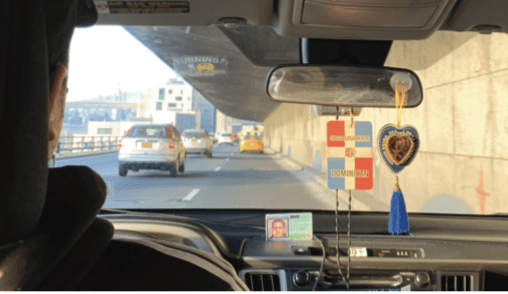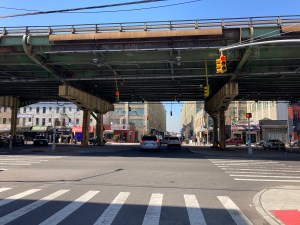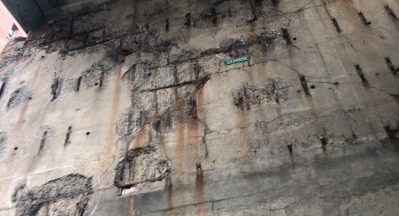$ix Questions About the Massive Brooklyn-Queens Expressway Plan$
Question 1: Isn't there a better use for $4 billion than to enshrine one of Robert Moses's most disastrous legacies?

What’s a livable streets activist to do?
The city is about to commit four-to-god-knows-how-many-billions of dollars to replace a 1.5-mile stretch of the crumbling Brooklyn-Queens Expressway under Brooklyn Heights — and one thing is increasingly, painfully, clear: there is a good chance that the de Blasio administration won’t learn from Robert Moses’s original mistake.
The mayor says the roadway is a critical part of New York’s infrastructure — but is it? Yes, 153,000 gas-guzzling vehicles — including about 14,000 trucks — use the BQE every day. But it serves no one else: not cyclists, not pedestrians, not even Brooklyn Heights residents, who are almost entirely cut off from the multi-billion-dollar Brooklyn Bridge Park so tantalizingly close.
The highway’s only positive attribute? It keeps many of those cars off local streets.
Or does it? Isn’t there a better solution than replacing a roadway that only creates more opportunity for drivers to pollute the air and clog our streets? And shouldn’t the livable streets community (good morning, all) play a more decisive role in the decision to commit so much money on a project that benefits so few and has so many downsides?
The Brooklyn-Queens Expressway is one the city’s largest projects ever, so it’s clearly an opportunity for transportation advocates and the livable streets movement to jump in and steer the conversation so the city doesn’t just make the same mistake it did 70 years ago by building the six-lane expressway in the first place.
We decided to ask the hard questions:
First, what are the prevailing plans and why should you care?
In September, the Department of Transportation proposed two equally expensive — and equally unpalatable — options for rehabilitating the triple cantilever structure between Atlantic Avenue and Sands Street: a $3.2- to $3.6-billion plan that would tear down the historic Brooklyn Heights Promenade to make room for a temporary six-lane highway until the new roadway is done in six years; or a $3.4- to $4-billion plan to rebuild the expressway lane by lane, potentially creating traffic jams for up to 12 miles, taking longer, costing more and lacking additional improvements to the Promenade and several interchanges.
Since then, Brooklyn Heights residents have used their considerable financial might to “save” the Promenade, and now there are multiple proposals are on the table — plus whatever comes from Mayor de Blasio’s just-created panel of “experts” that is charged with finalizing a plan by this summer:
- The Brooklyn Heights Association tapped local architect Marc Wouters to dream up an alternative plan to save the Promenade — but it would still allow for the same amount of traffic with six lanes. His proposal calls for creating a temporary two-level structure for expressway traffic closer to the Furman Street border of Brooklyn Bridge Park, featuring one level with three lanes for Bay Ridge–bound vehicles, and the second with three lanes headed towards Queens.
- Another longtime Brooklyn Heights resident, Mark Baker, has his own proposal: the tri-line plan, which would also allow for as many as 153,000 vehicles each day. Baker’s plan calls for relocating the BQE to a new road on Furman Street that would be enclosed in a “box-like” structure.
- Another local group, A Better Way, tapped the Regional Plan Association to come up with another plan. But the RPA stopped short of calling for the roadway to be fully torn down and proposed nixing just two lanes of traffic.
- Comptroller Scott Stringer wants to ban all cars, make the expressway truck-only, and cover it with parks [PDF].
- And the newest proposal is from firm Bjarke Ingels Group, which calls for a six-lane roadway decked over with a linear park. But BIG’s plan also would allow for the same amount of traffic.
- And, lest we forget, there are plenty of ways to reimagine the BQE as a low-impact, at-grade, tree-lined boulevard. Many cities — including New York after the West Side Highway started falling apart in the 1980s — have torn down ancient and bad elevated highways to stimulate growth, housing, parks and commerce. No heavy-hitter has revealed such a plan for the BQE, but someone will.

Why is the city capitulating to the Brooklyn Heights Association?
The powerful civic group made its bones when it got Moses to change his mind about building the highway through the tony neighborhood decades ago — a deal that ended up creating the fabled Promenade in the first place. Now flush with cash and influence, the BHA has again exerted itself, getting the city to change its mind about the BQE, which led to this week’s creation of the mayoral panel.
But still, the Brooklyn Heights Association clearly favors rebuilding the highway for 153,000 cars, as long as they are not in their neighborhood and as long as the new highway has some green space on top of it — locals applauded the Bjarke Ingels Group’s six-lane plan during the massive town hall last week, and the BHA endorses Wouter’s plan for six-lanes of traffic, just further from their homes.
The BHA is right to push for a better plan than what the city has so far come up with, but as long as there is room for more than 150,000 cars going through the neighborhood every day, there will still be pollution.
And several lower-income neighborhoods have similarly had to bear the brunt of traffic and air pollution, but their noise and suffering has yet to make the city look twice.
https://twitter.com/Yehuda_Pollack/status/1113805926929195008
The Brooklyn Heights Association has spent a total of about $85,000 on experts, and the local group fighting the city’s plans, A Better Way, spent $45,000 to lobby the city to find an alternative solution, according to reports.
Why didn’t the mayor put a single livable streets activist on the “expert” panel?
Mayor de Blasio named 16 people to an “expert” panel tasked with coming up with a new design for repairing the aging highway, saying the city needs to “get this right.” But whose definition of “right” will prevail? Clearly not the definition that favors a low-impact approach, given the composition of the panel: It’s stacked with engineers, architects, and other urban planners, and not a single person from the livable streets movement. StreetsPAC, Transportation Alternatives, Riders Alliance and other groups whose mission is to reclaim our streets from cars are not represented at all.
“I’m intrigued by the creation of this panel, there are smart people involved, but I would have liked to see maybe a couple more transportation advocates on the panel,” said StreetsPAC’s Eric McClure. “Hopefully, [the panel] will do some out-of-the-box thinking and really take a look at 20 to 30 years down the road what kind of environment do we want.”
Why is nobody talking about knocking it down entirely?
Of all the many proposals, none is bold enough to suggest knocking down the BQE in its entirety and turning in into a boulevard-style roadway — a precedent set in other cities around the world, including Seattle, South Korea, and even in our very own Manhattan.
Decades ago, the city tore down the West Side Highway, which according to the Regional Plan Association, used to carry about 140,000 vehicles per day, roughly the same amount as the BQE. Council Speaker Corey Johnson merely toyed with the idea when he suggested the city study tearing it down entirely.
But where would all the cars go?

The closest thought-out proposal to simply tearing down the BQE is Stringer’s plan to ban all cars and make the expressway truck-only between Hamilton Avenue in Carroll Gardens and the Brooklyn Bridge in Dumbo. Drivers would be diverted to either local roads, other expressways, or to public transportation.
But would local streets be overwhelmed with cars? Even the city’s top accountant doesn’t know.
“That’s the million-dollar question,” Stringer said on Wednesday at a town hall on the looming BQE-fix that drew hundreds of people and other local elected officials. But he wasn’t being facetious. The comptroller also reminded audience members about the well-proven theory of “induced demand,” namely that if a city builds more highway capacity, it creates more demand for those highways. At the same time, reducing lanes reduces the amount of driving. The only question is where will the cars go?
“We have to develop even more travel routes and bus routes. We have to make key investments with the money we save in reorganizing the bus system for this to work,” said Stringer. “Traffic does follow an iron rule: if you build more highways, you get more cars; if you eliminate highways, you get fewer cars.”
Stinger said city and state transportation officials must invest in expanding public transportation to pick up some of the slack from those commuters who decide to hop out of their cars and onto the busses or subways.
A large majority of cars on the BQE either use the free bridges (Brooklyn or Manhattan) or the Battery Tunnel to get into and out of Manhattan, Stringer said. That suggests that there are alternatives for the roadway between the tunnel and the bridges besides a super-highway.
Why is anyone even considering anything before the impact of congestion pricing is known?
The Department of Transportation will begin its environmental review of the project this summer — before it knows the impact of congestion pricing, which will not even begin until Jan. 1, 2021. Regardless of whether you support tolling drivers to get into Manhattan or not, the congestion pricing tolls have not even been set yet, so it is unclear how driving patterns will change.
One thing is certain: those patterns will change, so any traffic data that the DOT is using for its BQE plan will be obsolete overnight.

